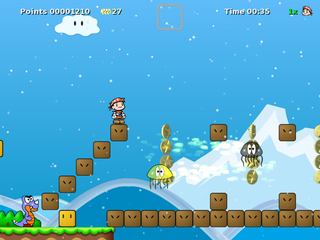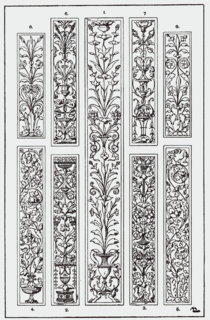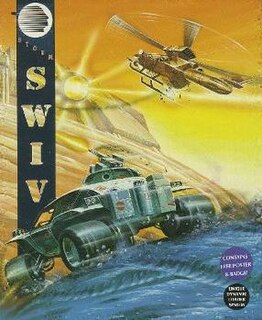| Look up scroll or scrolling in Wiktionary, the free dictionary. |
A scroll is a roll of parchment, papyrus, or paper, which has been drawn or written upon.
Contents
Scroll may also refer to:
| Look up scroll or scrolling in Wiktionary, the free dictionary. |
A scroll is a roll of parchment, papyrus, or paper, which has been drawn or written upon.
Scroll may also refer to:
| This disambiguation page lists articles associated with the title Scroll. If an internal link led you here, you may wish to change the link to point directly to the intended article. |

A website is a collection of web pages and related content that is identified by a common domain name and published on at least one web server. Notable examples are wikipedia.org, google.com, and amazon.com.
ESP may refer to:

The arabesque is a form of artistic decoration consisting of "surface decorations based on rhythmic linear patterns of scrolling and interlacing foliage, tendrils" or plain lines, often combined with other elements. Another definition is "Foliate ornament, used in the Islamic world, typically using leaves, derived from stylised half-palmettes, which were combined with spiralling stems". It usually consists of a single design which can be 'tiled' or seamlessly repeated as many times as desired. Within the very wide range of Eurasian decorative art that includes motifs matching this basic definition, the term "arabesque" is used consistently as a technical term by art historians to describe only elements of the decoration found in two phases: Islamic art from about the 9th century onwards, and European decorative art from the Renaissance onwards. Interlace and scroll decoration are terms used for most other types of similar patterns.
Parallax scrolling is a technique in computer graphics where background images move past the camera more slowly than foreground images, creating an illusion of depth in a 2D scene of distance. The technique grew out of the multiplane camera technique used in traditional animation since the 1930s. Parallax scrolling was popularized in 2D computer graphics and video games by the arcade games Moon Patrol and Jungle Hunt, both released in 1982. Some parallax scrolling had earlier been used by the 1981 arcade game Jump Bug.

A playlist is a list of video or audio files that can be played back on a media player either sequentially or in a shuffled order. In its most general form, an audio playlist is simply a list of songs, but sometimes a loop. The term has several specialized meanings in the realms of television broadcasting, radio broadcasting and personal computers.

StepMania is a cross-platform rhythm video game and engine. It was originally developed as a simulator of Konami's arcade game series Dance Dance Revolution, and has since evolved into an extensible rhythm game engine capable of supporting a variety of rhythm-based game types. Released under the MIT License, StepMania is open-source free software.

In computer displays, filmmaking, television production, and other kinetic displays, scrolling is sliding text, images or video across a monitor or display, vertically or horizontally. "Scrolling," as such, does not change the layout of the text or pictures but moves the user's view across what is apparently a larger image that is not wholly seen. A common television and movie special effect is to scroll credits, while leaving the background stationary. Scrolling may take place completely without user intervention or, on an interactive device, be triggered by touchscreen or a keypress and continue without further intervention until a further user action, or be entirely controlled by input devices.

A hanging scroll is one of the many traditional ways to display and exhibit East Asian painting and calligraphy. The hanging scroll was displayed in a room for appreciation; it is to be distinguished from the handscroll, which was narrower and designed to be viewed flat on a table in sections and then stored away again.
Fueled by the previous year's release of the colorful and appealing Pac-Man, the audience for arcade games in 1981 became much wider. Pac-Man influenced maze games began appearing in arcades and on home systems. Nintendo broke from their mediocre early releases with Donkey Kong which defined the platform genre.

The palmette is a motif in decorative art which, in its most characteristic expression, resembles the fan-shaped leaves of a palm tree. It has a far-reaching history, originating in ancient Egypt with a subsequent development through the art of most of Eurasia, often in forms that bear relatively little resemblance to the original. In ancient Greek and Roman uses it is also known as the anthemion. It is found in most artistic media, but especially as an architectural ornament, whether carved or painted, and painted on ceramics. It is very often a component of the design of a frieze or border. The complex evolution of the palmette was first traced by Alois Riegl in his Stilfragen of 1893. The half-palmette, bisected vertically, is also a very common motif, found in many mutated and vestigial forms, and especially important in the development of plant-based scroll ornament.

The scroll in art is an element of ornament and graphic design featuring spirals and rolling incomplete circle motifs, some of which resemble the edge-on view of a book or document in scroll form, though many types are plant-scrolls, which loosely represent plant forms such as vines, with leaves or flowers attached. Scrollwork is a term for some forms of decoration dominated by spiralling scrolls, today used in popular language for two-dimensional decorative flourishes and arabesques of all kinds, especially those with circular or spiralling shapes.

A side-scrolling game or side-scroller is a video game in which the gameplay action is viewed from a side-view camera angle, and as the player's character moves left or right, the screen scrolls with them. These games make use of scrolling computer display technology. The move from single-screen or flip-screen graphics to scrolling graphics, during the golden age of video arcade games and during third-generation consoles, would prove to be a pivotal leap in game design, comparable to the move to 3D graphics during the fifth generation.

Margent is a vertical arrangement of flowers, leaves or hanging vines used as a decorative ornament in architecture and furniture design in the 17th and 18th century. This motif was developed as a complement to other decorative ornaments, hanging as "drops" at the ends of a festoon or swag. Also used to accentuate the vertical lines of window frames and centered in ornamental panels.

SWIV is a 2D vertically scrolling Shoot 'em up game originally released in 1991 for the Commodore Amiga, Atari ST, Commodore 64, ZX Spectrum and Amstrad CPC home computer formats. It was converted to the Game Boy Color in 2001.
The PlayStation Portable system software is the official firmware for the PlayStation Portable. It uses the XrossMediaBar (XMB) as its user interface, similar to the PlayStation 3 console. Updates add new functionality as well as security patches to prevent homebrew applications and plugins from being executed on the system. Updates can be obtained in four ways:

Spider-Man is a vertically scrolling action game written by Laura Nikolich for the Atari 2600 and released in 1982 by Parker Brothers. It was both the first video game to feature Spider-Man and the first Marvel Comics based video game.
The handscroll is a long, narrow, horizontal scroll format in East Asia used for calligraphy or paintings. A handscroll usually measures up to several meters in length and around 25–40 cm in height. Handscrolls are generally viewed starting from the right end. This kind of scroll is intended to be read or viewed flat on a table, in sections. The format thus allows for the depiction of a continuous narrative or journey.
A vertically scrolling video game or vertical scroller is a video game in which the player views the field of play principally from a top-down perspective, while the background scrolls from the top of the screen to the bottom to create the illusion that the player character is moving in the game world.
An online video platform (OVP), provided by a video hosting service, enables users to upload, convert, store and play back video content on the Internet, often via a structured, large-scale system that may generate revenue. Users generally will upload video content via the hosting service's website, mobile or desktop application, or other interface (API). The type of video content uploaded might be anything from shorts to full-length TV shows and movies. The video host stores the video on its server and offers users the ability to enable different types of embed codes or links that allow others to view the video content. The website, mainly used as the video hosting website, is usually called the video sharing website.

A vertical video is a video created either by a camera or computer that is intended for viewing in portrait mode, producing an image that is taller than it is wide. It thus sits in opposition to the multiple horizontal formats normalised by cinema and television, which trace their lineage from the proscenium theatre, Western landscape painting traditions, our visual field and the plane we live on.